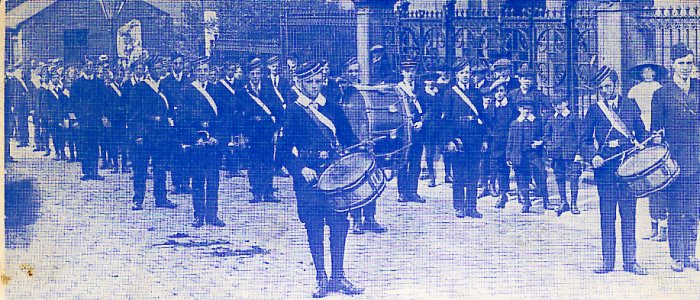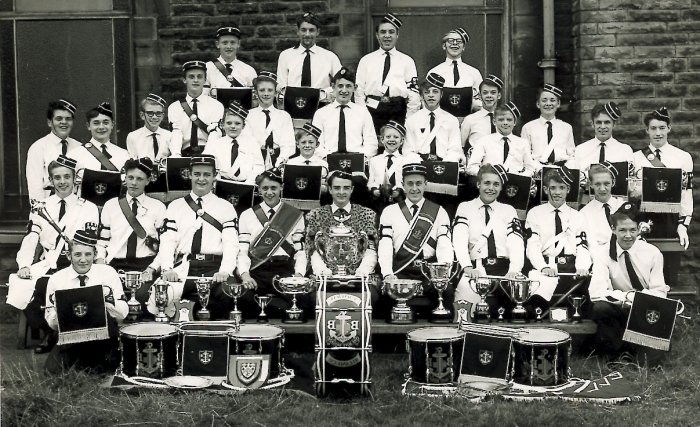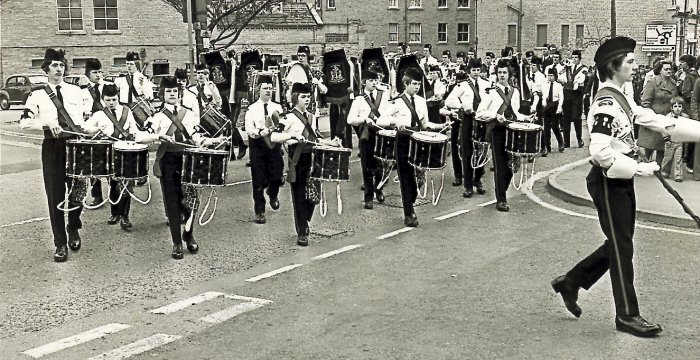History of The Anchormen
One of the oldest Corps in the United Kingdom – the Anchormen – can trace its roots back to July 1904 when the Boys Brigade came to Elland in West Yorkshire. The Company was enrolled and in uniform by 1905 and shortly afterwards a drum and bugle band paraded the streets of Elland. In 1910 under the captaincy of Mr Harold Savage the band grew in numbers and in 1932 at a cost to himself, built adjoining the Elland Wesley Church the Harold Savage Hall now the headquarters of the present day Anchormen.
During the 1930’s cornets were introduced to the range of drums and bugles and continued as such until 1954 when a young Selwyn Bottomley then lead drummer took an even younger Mick Moss and asked “would you like to play a drum lad?” – the rest is history.
The start of the Anchormen
In 1958 Selwyn Bottomley took over the role as bandmaster and Mick Moss became Drum Major and head of percussion. In the summer of 1961 the band now with bugles, snare drums, tenor drums and a bass drum entered its first competition at Brighouse, and came last.
From this competition sprang the desire to improve on three fronts smartness, instrumentation and playing ability. 1964 saw the fruition of these aims. Gone were the jackets revealing distinctive crisp white shirts. Gone were the bugles, cornets and narrow pattern side drums and in their place seperate tension drums and E flat trumpets. As for the playing ability, four championships were entered and four championship titles were won, the trophies literally pouring into Elland. It was at this point that the band began to use the anchor, the emblem of the Boys Brigade, into their marching display and it was from this that the 5th Halifax (Elland) BB Company adopted the name “Anchormen”.
It was as the Anchormen that in September 1964 the band entered the Midlands Youth Organisation Championships at Villa Park, widely regarded as the premier contest in the British Isles, and took the title of Champions, the first time ever the Championship had been won by a northern band.
Continued success
During 1965 the band continued with its success. The purchase of two bell lyres increased the membership. On the 10th of June 1967 the band appeared on “Opportunity Knocks” and later that year performed on “Junior Showtime”. It was also the year when the band performed at the Royal Albert Hall as guests of the London District of the Boys Brigade.
In July 1969 the band visited Denmark to represent England at an International Musical Festival held at Odense, on the island of Funen. The band returned through Germany and Holland playing in fornt of the Royal Palace in Amsterdam. It was on theis visit that a firm and lasting friendship was established with the Amsterdam BB creating the opportunity for many return visits to Holland for Drum Corps shows and Winterguard competitions.
Recording 2 LP’s
1974 the Anchormen was again at the forefront of the marching band scene when they took the first ever national Boys Brigade Championship, a title that they held six times in the next seven years. In 1974 was also the year the band made its first LP record “The Anchormen”, a second LP “Supreme Champions” was produced three years later.
By 1979 there was a distinct change in the marching band activity. Drum Corps from the United States were what everyone was talking about. The Anchormen also followed the trend and with the Girls Brigade operating out of the same church it seemed the obvious solution to incorporate the girls into the new “Corps”. By the end of 1979 the Anchormen had purchased new “G” horns plus marching percussion including marching marimbas, bells xylophone and vibraphone and the Corps proudest possession, four marching timpani. By 1981 Drum Corps United Kingdom was well established and in the Championship that year the Anchormen gained 7th place.
1982 saw the corps in the “Nelson” style naval uniforms and to go with it the seafaring tunes such as “Sea Hawk”, “Russian Sailors Dance” and “Mutiny On The Bounty”. These together with the Blue Stars “Trilogy” and in 1983 the Cavaliers “Softly As I Leave You” complete with the memorable step over the guard by the whole Corps, gave the Anchormen 3rd place at Championships, and a memorable appearance in “Bands of Gold” on Channel 4 television. In August 1983 the Anchormen received possible their greatest acclaim when they were asked to perform at the Centenary Celebrations of the Boys Brigade in Glasgow, possibly their most memorable performance ever.
The start of Winterguard
Over the next few years the Anchormen also gained a reputation for “Winterguard” and in 1984 hosted a visit to the UK by the top American guard “Top Hats” from Towanda, Pennsylvania. In the previous year Top Hats reached the top eight in the States with their “Rhapsody In Blue” which the Anchormen used for their 1984 show.
The visit also included a joint trip to Holland were both guards competed in a DCI regional competition at Nieuwegein. The highlight of that visit was to see the live performance of the Cavaliers famous “James Bond” winterguard performance, probably the best guard show ever seen on a winterguard circuit. The following year the Anchormen performed the Top Hats show “Big Noise From Winnetka” finishing with the now famous “fans routine” and gaining 3rd position in the finals held that year at the Wembley Conference Centre.
The next few years saw a lull in the activities of the Anchormen on the field but not at home. The Corps still had its own buses for transportation but a decision to withdraw from the Boys Brigade and to go independant had taken its toll. With some members ageing out and with practices now being shared with all the other activities at Southgate Methodist Church in the centre of Elland, the problems of continuity and the sharing of facilities became acute. In 1986 Nu-Swift International gaves the Corps permission to use the Savage Hall, the old home of the Boys Brigade, which they had purchased as a repair factory for their fire extinguishers. For two years the Corps used the facilities and in 1986 were invited to buy the premises for £15,000. A deposit of £3,000 was raised, a mortgage was arranged and within a few months the Anchormen had a place they could call Home.
Despite the advantages of having excellent facilities and a sound financial base in 1987 things did not go well. With problems within DCUK, the Corps with many others had joined together to form The Britsh Drum Corps Federation. Some members had left to join the newly formed Conquest Alliance at Birghouse and disagereement among the staff as to the way forward was not helping in these difficult times. In October 1987 the management committee of the Anchormen and trustees of the Corps asked Mick Moss to take over as Corps Director. A new treasurer and secretary were elected and a rebuilding programme was put into operation. In 1988 the Corps did not compete but took time out to recuit new members and concentrate on the growing Cadet Corps under the control of Chris Wright.
Competing in A Class
By 1989 the Corps was back in competition in “A” class. During the Winter the colour guard had re-established itself in Wintergaurd and in 1990 reached 9th and exhibition spot at finals.
Early in 1990 close neighbours “Nothern Lights” were experiencing a shortage of teaching staff and would probably not have marched during the coming season. Consultation between the two Corps staff realised that both had the same ains and ambitions and it was agreed that thw Corps would march together as Anchormen and Northern Lights for the coming season.
1992 saw the success of the partnership when winterguard teams had tremendous success with the Cadets as champions, Anchormen Image well placed in open class and Anchormen taking 4th place at finals.
Change of style
In 1994 the Anchormen incorporated a change of style, change of uniform and a different attitude to its performance. Concentration on musicality, colourful display and entertainment were, and still are, our main objectives. In the summer season of ’94 with a formula of finals at Nottingham and a programme of “Robin Hood Prince of Thieves” something special had to happen and in a performance that shocked everyone they reached finals for the first time in many years. From then they did not look back with 7th place in 1995 with the 3 Musketeers, 2nd in 1996 with “Anthems of an American Past” and second again in 1997 with “American Faces” a finals many thought should have taken the champions trophy.
Unforgettable Freddie Mercury
In Winterguard with performances such as “Freddie Murcury, the Performance” and “Cirque du Soleil” and an unforgettable James Bond “Licensed to Thrill” the Anchormen guard constantly brought the house down with their performances. With high-risk equipment, unbelievable exchanges and an incredibly fast drill book you never had to look when the Anchormen took the field the audience told you. Despite this the Anchormen’s type of entertainment did not suit the judges criteria and the championship that many thought should have come to Elland on at least two occasions sadly never did. In supporting the activity for a decade in both Corps & Winterguard did we ask too much of our loyal members?
If we had, like many more, chose just the one would that have brought the elusive “gold” one thing is for sure the when they look back at the 90’s the name of the Anchormen will consistently come to the fore
What is Drum Corps?
Imagine yourself sitting in the stands at your local stadium, tapping your feet to your favourite tunes and watching one of the most artistic musical programmes in the world. You are experiencing the sights and sounds of today’s Drum and Bugle Corps.
Corps of the 90’s are a far cry from the local marching bands you knew 10 to 20 years ago. It is disciplined, precise audio-visual pageantry. The drum corps hobby combines practice and competition to produce semi-military marching displays, all precisely choreographed to a variety of music ranging from Broadway musicals, to Big Band jazz, through modern pop and classics of the Masters.
Drum Corps Instruments
The instruments used in modern day Drum and Bugle Corps differ considerably from those of the traditional brass or military band. They have been specifically designed to project the very individual sound of Drum Corps from the performance arena to the fans in the stands.
The brass section plays a choice of valved bugles pitched in G/F. To produce the deep and overall distinctive sound, there are a range of voices from soprano to contrabass.
The marching battery percussion usually comprise projector snare drums, bass drums, clusters of tuned tenor tom-toms and a series of sized cymbals. In addition most Corps feature a static percussion “pit” comprising xylophones, timpani, bells, chimes and a whole host of percussion accessories. All members are taught to read music and learn to handle very complex musical arrangements.
What is Colourguard?
With origins in the military tradition of providing an ammend escort for a regimental colour, today’s Drum Corps Colour Guards provide the visual interpretation of the music played by the Corps. They employ flags, imitation rifles, hoops, capes and many other ‘props’ to add to the overall excitement and entertainment provided by the Corps. Members of a Colour Guard develop skills of marching, jazz dance and equipment handling in the presentation of a complex routine – either on the summer contest field or in a series of indoor competitions known as “Winterguard”. Colour Guard gives the opportunity to its members for their own personal development in these alibilities leading to the self-confidence and poise that helps in all walks of life.












